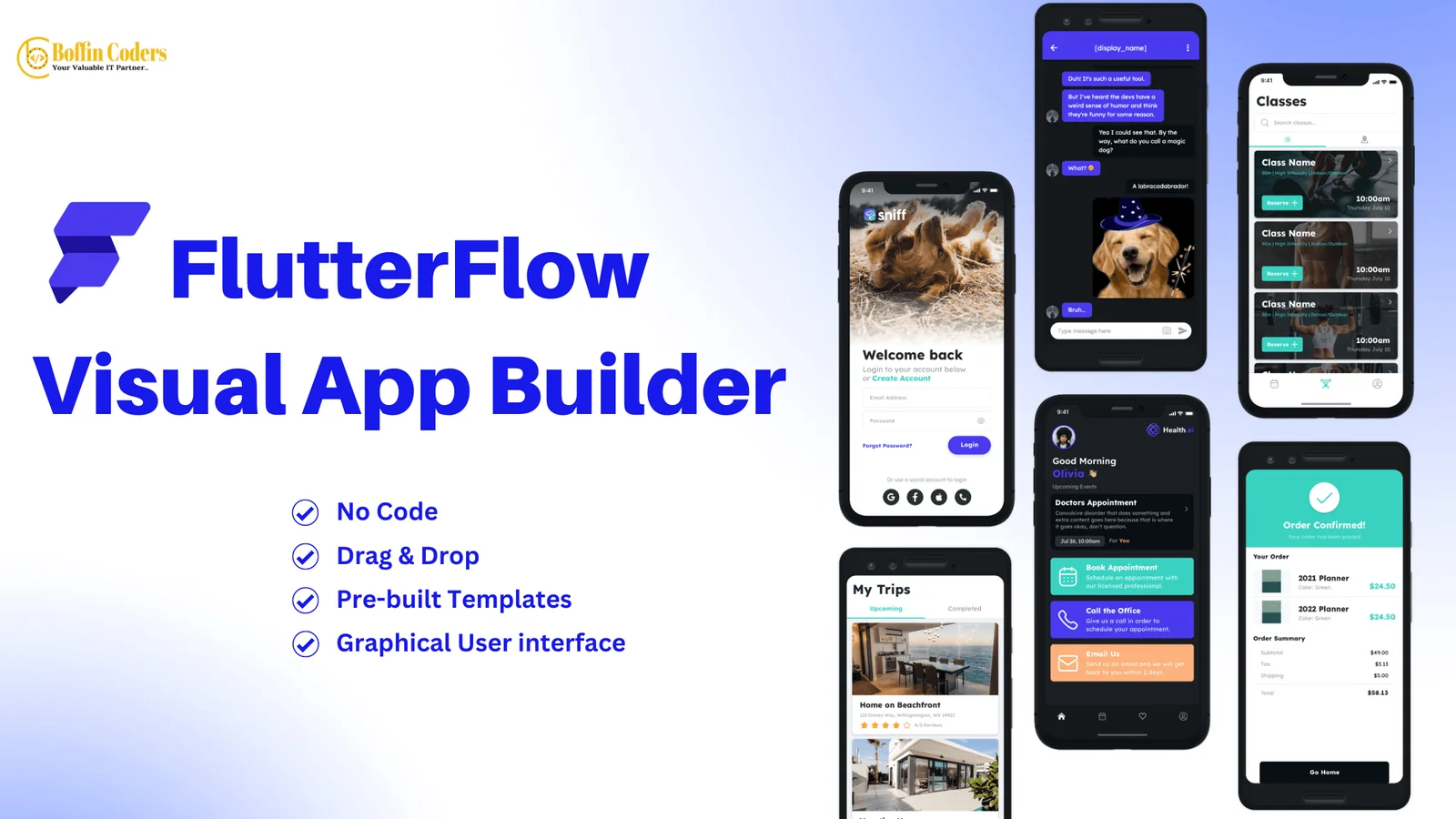FlutterFlow is a visual app builder that allows a person build an app without any coding. It has elemental templates that you can drag-and-drop to create an impressive app interface. Its simple interface can create a basic app to a professional app with simple functions. It has a support for both Android and iOS, which comes with various templates.
FlutterFlow is based on the Popular Google Flutter Framework, and you can write in Dart, an easy to learn programming language. It has a visual interface that supports animations, and gestures, or you can add Firebase services to your app, such as authentication and cloud storage.
How to Use FlutterFlow
When you install and open the interface, you will find many themes for your app on which you can start working on. You can choose an empty workplace to create the layout from the scratch and the different elements are available to you. These elements do not need to be coded separately each time you use them, rather you can drag and drop whatever element you want in your app.
There are basically three layout categories you have to choose from before you can start working.
Canvas: The canvas is the layout space you can use for adding widgets of your choice. Any widget you like, you can drag and drop them to the canvas and re-size the widget according to your requirement.
Toolbar: You can find all the available tools and widgets in one place, the toolbar. Widgets in the toolbar also serve as a guide to learn about the different applications of these tools.
Properties Panel: You can customize any widget from the properties panel. From changing colors to providing placeholders, you can fully customize any widget you place in your canvas.
What can FlutterFlow Build?
You can see the development in real time on your device or on a virtual device. The animation supports enables you to add some very attractive features to the app layout. All this is possible without the need for you to write a single line of code. You can drag and drop any element you like, configure it in any suitable way, and FlutterFlow will generate the appropriate code by itself.
The code can be modified freely if you wish to, else you can keep working on the visual editor, and the code will keep updating by itself. This may sound way too easy, but it doesn’t mean the app it produces are of low quality. The predefined widgets comes with high visual quality and animation. Thus, it is suitable for making even complex commercial use applications.
How to Make an App Using FlutterFlow?
When you are using FlutterFlow, you can enjoy these features:
- Drag and Drop pre-built UI elements
- Connect UI components to Data Sources
- Customize your app’s appearance
- App’s code gets generated automatically
- Run your app on Android or iOS Devices
When you start your project, it gives you multiple theme templates to choose from, making your job a lot easier. With a little customization, you can mold the appearance according to your liking.
What Type of Apps FlutterFlow Can Make?
The job sound too easy to believe, but there are many different apps you can create on this visual editor. You can almost build any app with FlutterFlow:
- Fitness Apps
- Messaging Apps
- Social Media Apps
- Photo and Video editing Apps
- Shopping Apps
- Productivity Apps
Flutter or FlutterFlow
Flutter is an app builder, fully loaded with SDKs and app frameworks, which don’t find with FlutterFlow. You can Hire Flutter Developer to run your existing code in FlutterFlow for future use, or to update your app quickly. You can consider a few points before choosing an appropriate platform to build your app.
1. Development Time
Flutter takes two to six weeks time to learn and code an app’s interface. Whereas with simple drag and drop features of FlutterFlow, the job can be done within three to four weeks. It is helpful for businesses who are looking for an alternative to save their time.
2. Features and Widgets
Flutter has many advanced features and more features are added with every update. On the other hand, FlutterFlow is still new and has less features. The developers are adding features to FlutterFlow, but still hasn’t reached a better spot than Flutter. Even though, FlutterFlow is able to gain attention from new coders, and people you are not willing to code at all. The feature to drag and drop widgets without worrying about the coding part, ease the job for many. If you are looking for high customization and much more complex apps, then Flutter is the solution for it.
3.Visual App Design
FlutterFlow is a handy tool to create custom layouts and UI. It provides its users with dedicated UI Designer interface, and you can put elements as you wish them to appear on screen.
Flutter is a difficult job to do, if you are building custom widgets and layouts. You have to code every detail of widget and keep checking the changes in the layout on the device separately. It is difficult to align elements and make them appear the way you intend without the help of an experienced developer.
4. Errors & Fixes
Both platforms have drawbacks of their own. But the fact is that, Flutter is an established programming language and thus has gone through multiple updates. It has build a strong community which continuously contributes towards fixing the errors.
Meanwhile, FlutterFlow don’t have a large community to rectify its errors and lack behind Flutter when it comes to fixing errors. Despite this, FlutterFlow is a newly launched technology and has less bugs already. It is safe to consider that it is going to advance rapidly in the near future.
5. Ease of Deployment
FlutterFlow makes the deployment easier, a process consisting of coding software, assembling the project in a virtual machine image, and making the image ready for deployment.
Unlike Futter, it doesn’t require dedicated developers to do the job.
Common Mistakes While Using FlutterFlow
Even though FlutterFlow is easy to use, sometimes people may get stuck at some particular point because of some common mistakes that happens with this technology.
1. Not Adding New Widgets
People add new widget to their app, but forget to add it to their FlutterFlow project as well. In such cases, the output don’t reflect the changes you make with that new widget.
2. Not Connecting Widgets
It is necessary that you maintain link between the widgets, else they will be unable to transfer data among themselves, and your data from one widget will never reach at the other end.
3. Incorrect Connection Between Widgets
It is common that people pass incompatible data from one widget to another. It will make your widget unable to understand data from the previous one, and thus can’t process it to transfer to the next widget. So, it is essential to keep testing that your data input is reaching to the end widget without failure.
Conclusion
FlutterFlow is a promising technology that shows signs of growing into something better in the near future. To make sure you stay ahead of your competitors, you can consult with Boffin Coders to learn more about FlutterFlow. You can hire our flutter developers to start creating your app with FlutterFlow and you can deploy your app before any of your competitors.

As a blog author, I have a strong passion for staying up-to-date with the latest trends and technologies. My expertise lies in WordPress development, SEO optimization, and content writing. Whether you have an idea for a website, mobile app, or custom software, our team is here to guide you. Get a free consultationwith us. Additionally, I am available to provide the best SEO and content writing services to boost your online presence.

